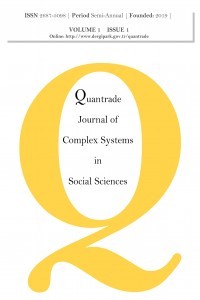The Effect Of Investors’ Cognitive Bias On Stock Decision Making
The Effect Of Investors’ Cognitive Bias On Stock Decision Making
There have been many differences in the evolving process from the traditional economy to the behavioral economy. Conventional finance has made progress within the framework of rational choice and expected benefit asumptions. Behavioral finanse is based on expectation theory. In fact, it is based on the argument that individuals are not fully rational. Within the scope of irrational act of individuals, the ability to select stocks has been illusory. The point is that different ways of thinking ocur. It is seen that buyer and seller perspectives are opposite to each other with a complex thinking. In other words, when buyers buy stocks, the price is low and this may increase, and sellers think that the price is too high and may fall. In fact, it is a complex structure of how buyers and sellers in the markets are convinced that a certain price is uncertain. The aim of this study is to investigate the effect of decision-making process on investor emotional prejudices, whether the decision mechanisms are more effective when buying stocks in the market or the idea that people are competent to know more than the market.
Keywords:
Behavioral Finance Decision Mechanisms,
___
- Aksoy, E. (2016). Irrational Investor Behavior and Cognitive Biases Effective in Decision Making: ISEExample(Master Thesis). Istanbul University Institute of Social Sciences, Istanbul.
- Angı, G. G., Bekçi, I.,&Karataş, Ö.N. (2016) A research on the cognitive biases of individual stock investors. Journal of Accounting &Finances, (70).
- Asoy, E., & Saldanlı, A. (2017). Are investors rational? Over-confidence to ISEanda study on the biases of extreme optimism. Journal of Politics, Economics and Management Research, 5(1).
- Aydın, Ü., & Ağan, B. (2016). The effect of irrational decisions on financial investment preferences: an application within the framework of behavioral finance. Journal of Economic and Social Research, 12(2), 95-112.
- Bektur, Ç., & Atasaygın, S. (2017). On the evaluation of stock investment decisions within the scope of excessive trust and representative investor. In ICPESS (International Congress on Politic, Economic and Social Studies),3.
- Camerer, C. F., & Loewenstein, G. (2003). Behavioral economics: Past, present, future.
- Chen, Y. W., Chou, R. K., & Lin, C. B. (2019). Investor sentiment, SEO market timing, and stock price performance. Journal of Empirical Finance, 51, 28-43.
- De Long, J. B., Shleifer, A., Summers, L. H., & Waldmann, R. J. (1990). Positive feedback investment strategies and destabilizing rational speculation. the Journal of Finance, 45(2), 379-395.
- Decamps, J. P., & Lovo, S. (2002). Risk aversion and herd behavior in financial markets. Available at SSRN 301962.
- DeVault, L., Sias, R., & Starks, L. (2019). Sentiment metrics and investor demand. The Journal of Finance, 74(2), 985-1024.
- Hayta, A. B. (2014). Psychological biases affecting individual investors' financial risk perception.. Turkey Social Studies Journal, 183(183), 329-352.
- Kahyaoğlu, M. B. (2011). The role of gender on the level of exposure to various emotional and psychological factors affecting investment decisions: An application on ISE individual stock investors. Journal of Economic and Social Research, 7 (1), 29-51.
- Kahyaoğlu, M. B., & Ülkü, S. (2012). The effect of representation hristristiki on perceived risk: An application on ISE individual stock investors. International Journal of Alanya Faculty of Business, 4(1), 53-59.
- Kalaycı, Ş. (2010). Multivariate statistical techniques with SPSS. Ankara: Dynamic Academy.
- Küçüksille, E., & Usul, H. (2012). Cognitive biases and their effects on investor decisions. Yalova University Journal of Social Sciences, 2(4), 24-35.
- Lee, C. M., Shleifer, A., & Thaler, R. H. (1991). Investor sentiment and the closed‐end fund puzzle. The journal of finance, 46(1), 75-109.
- Nguyen, T., & Schuessler, A. (2012). Investment decisions and socio-demographic characteristics–empirical evidence from Germany. International Journal of Economics and Finance, 4(9), 1-12.
- Odean, T. (1998). Are investors reluctant to realize their losses?. The Journal of finance, 53(5), 1775-1798.
- Sefil, S., & Çilingiroğlu, H. K. (2011). Foundations of Behavioral Fiance: cognitive and emotional tendencies of decision making. Istanbul Commerce University Journal of Social Sciences, 10 (19), 247-268.
- Statman, M. (1999). Behaviorial finance: Past battles and future engagements. Financial Analysts Journal, 55(6), 18-27.
- Tekin, B. (2016). Conventional finance-behavioral finance distinctionin the contex of Expected Utility and Expectation Theories. Journal of Accounting, Finance and Auditing Studies, 2(4), 75.
- Tekin, B. (2018). 'Behavioral finance' as the human dimension of finance in the context of cognitive bias and hristristic: a literature review and compilation.International Journal of Human Studies, 1(2), 35-62.
- Thaler, R. H. (1999). Mental accounting matters. Journal of Behavioral decision making, 12(3), 183-206.
- Turguttopbaş, P. (2008). The Effects of Investor Behavior on Financial Decisions (Behavioral Finance) and Testing Behavioral Finance Theories at ISE (Ph.D. Thesis). Gazi University Institute of Social Sciences, Ankara.
- Tversky, A., & Kahneman, D. (1971). Belief in the law of small numbers. Psychological bulletin, 76(2), 105.
- Tversky, A., & Kahneman, D. (1974). Judgment under uncertainty: Heuristics and biases. Science, 185(4157), 1124-1131.
- Yayın Aralığı: Yılda 2 Sayı
- Başlangıç: 2019
- Yayıncı: Tolga ULUSOY
